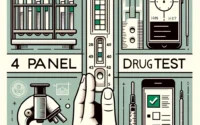Follicle Drug Testing: Understanding the Process, Benefits, and Limitations
Last Updated on July 4, 2023 by Lily
Drug testing plays a crucial role in various contexts, including employment screening, legal proceedings, and substance abuse treatment programs. Among the different drug testing methods available, follicle drug testing has gained significant attention due to its ability to detect drug use over an extended period. In this article, we will explore follicle drug testing in detail, including its process, benefits, and limitations.
What is Follicle Drug Testing?
Follicle drug testing, also known as hair drug testing, is a method used to detect the presence of drugs in an individual’s hair follicles. It involves analyzing a small sample of hair to identify drug metabolites that have been incorporated into the hair shaft over time. The primary purpose of follicle drug testing is to provide a reliable and accurate assessment of an individual’s drug use history.
How Does Follicle Drug Testing Work?
Follicle drug testing relies on the fact that when drugs are consumed, they are metabolized and enter the bloodstream. As the hair grows, these drug metabolites are transported from the bloodstream to the hair follicles, where they become trapped within the hair shaft. By analyzing a segment of hair, typically from the scalp, drug testing laboratories can identify and quantify the presence of various substances, including illicit drugs and certain prescription medications.
The Process of Follicle Drug Testing:
A. Sample Collection:
To perform follicle drug testing, a small sample of hair is collected from the individual undergoing the test. The hair is typically cut as close to the scalp as possible to provide the most recent history of drug use. It is essential to collect an adequate amount of hair to ensure accurate testing results.
B. Laboratory Analysis:
Once the hair sample is collected, it is sent to a specialized laboratory for analysis. In the laboratory, the hair undergoes a multi-step process, including washing to remove external contaminants, extraction of drug metabolites, and testing using advanced analytical techniques such as gas chromatography-mass spectrometry (GC-MS) or liquid chromatography-tandem mass spectrometry (LC-MS/MS). These techniques allow for the identification and quantification of specific drugs or their metabolites present in the hair sample.
Benefits of Follicle Drug Testing:
A. Detection Window:
One of the primary advantages of follicle drug testing is its extended detection window. Unlike urine or blood tests, which can only detect recent drug use, hair follicle testing can detect drug use that occurred up to 90 days prior to the test. This longer detection window makes it an ideal method for detecting chronic drug use and identifying patterns of substance abuse over time.
B. Difficult to Manipulate:
Follicle drug testing is considered difficult to manipulate compared to other drug testing methods. While individuals may try to adulterate or substitute urine samples, it is challenging to alter the drug metabolites incorporated into the hair shaft. This makes follicle drug testing a more reliable method for detecting drug use.
C. Comprehensive Drug History:
Since hair grows at an average rate of about half an inch per month, different segments of the hair shaft can represent different time periods. By analyzing multiple segments of hair, it is possible to create a comprehensive drug use history, providing insights into an individual’s substance abuse patterns over an extended period.
IV. Limitations of Follicle Drug Testing:
A. Timeframe of Detection:
While the extended detection window is a benefit, it can also be a limitation in certain cases. Follicle drug testing cannot provide precise information on the timing of drug use, as it can only determine drug use within the past 90 days. This limitation makes it challenging to establish whether drug use occurred recently or further back in time.
B. External Contaminants:
Although laboratories take precautions to remove external contaminants from hair samples, it is still possible for substances such as drugs or environmental pollutants to be deposited on the hair shaft. This may result in false-positive results or the detection of substances that were not directly ingested by the individual.
C. Inability to Detect Recent Drug Use:
While follicle drug testing excels in detecting long-term drug use. It may not be as effective in identifying recent drug use. Since it takes approximately 5-10 days for drug metabolites to be incorporated into the hair shaft. Follicle drug testing may not provide accurate results for drug use that occurred within this short timeframe.
Conclusion:
Follicle drug testing is a valuable method for detecting long-term drug use and establishing an individual’s substance abuse history. With its extended detection window, difficulty in manipulation, and comprehensive drug history analysis. Follicle drug testing offers several benefits in various contexts. However, it is crucial to consider the limitations, such as the inability to determine. The timing of drug use and the possibility of external contamination. By understanding the process, benefits, and limitations of follicle drug testing, individuals and organizations. Can make informed decisions regarding drug testing protocols and interpretation of results.



